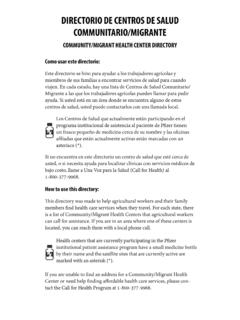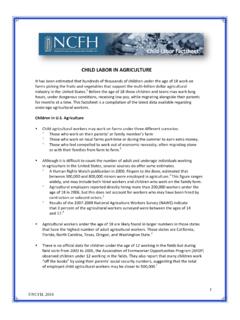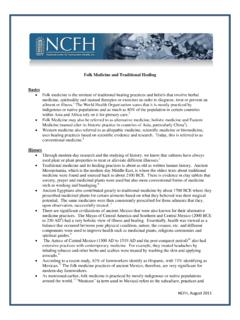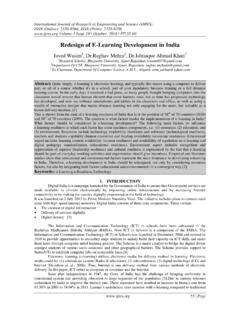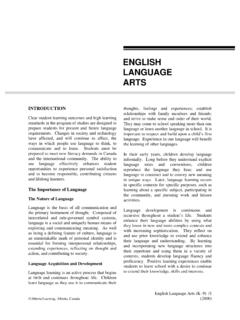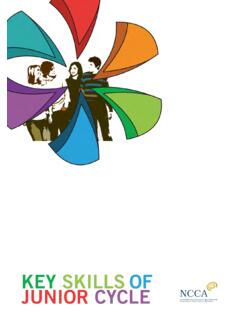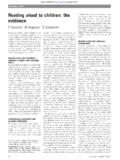Transcription of Choosing Effective Health Education Tools To Reach Your ...
1 Choosing Effective Health Education Tools To Reach Your Patients Presenters: Evangelina Orozco Monica Fossi Joanna Arevalo 2014 Midwest Stream Farmworker Health Forum Thursday, November 20th , 3:30pm 5:00pm Learning Objectives Understand Health literacy and how it impacts Health Education Recognize key risk factors and behaviors of limited literacy Improve strategies for conveying clear Health Education messages Identify the principles for creating and assessing Effective Health Education Tools NCFH 2014. A two-year old is diagnosed with an inner ear infection and prescribed an antibiotic. Her mother understands that her daughter should take the prescribed medication twice a day. After carefully studying the label on the bottle she decides that it doesn't tell how to take the medicine. She fills a teaspoon and pours the antibiotic into her daughter's ear. Source: Literacy Volunteers of America NCFH 2014. Health Literacy: Definitions read, understand and act.
2 Make appropriate decisions . obtain, process, and understand information . Sources: Institute of Medicine, Healthy People 2020, American Medical Association What is Health Literacy? Reading ability is the strongest factor, but it is NOT simply the ability to read. Health literacy requires a complex group of reading, listening, analytical and decision-making skills and the ability to apply these skills to Health situations. Assumes an advanced level of knowledge. NCFH 2014. Skills Needed in Health Care Access Information Provide Consent Recognize cues to Communicate with action professionals Access Care Provide info for assessment &. Navigate Institutions diagnosis Complete Forms Understand directions Follow regimen Advocate Source: Rudd, RE. Literacy and implications for navigating healthcare, 2002. Harvard School of Public Health : Health Literacy Website NCFH 2014. What do the Pictures Really Mean?? NCFH 2014. 2003 National Assessment of Adult Literacy (NAAL).
3 Source: NCFH 2014. 2003 NAAL found that . 33% Were unable to read basic Health care materials 42% Could not comprehend directions for taking medication on an empty stomach 26% Were unable to understand information on an appointment slip 86% Did not understand the rights and responsibilities section of a Medicaid application 60% Did not understand a standard informed consent 78% Misinterpret warnings on prescription labels Source: 2003 NAAL Survey, US Dept of Education . NCFH 2014. Directly Impacts Health Outcomes Patients struggle to understand basic medical forms, instructions and Health prevention information Patients more likely to have a chronic condition and less like to get care they need Patients use more Health care services, and incur higher Health care costs Poorer Health status higher among patients with low Health literacy NCFH 2013. Financial Consequences for Health Care System It is up to the Health care system to be sure patients understand the information they receive well enough to apply it Estimated $32 to $58 billion in additional costs Patients with low literacy use more Health care services, and use more publically financed Health care services NCFH 2013.
4 A Legal Concern for Health Care Professionals Poor compliance with medication and care can be dangerous to patients' lives It is up to the Health care system to be sure patients understand the information they receive well enough to apply it NCFH 2013. How does Health literacy impact your work? NCFH 2014. Who is at Risk of Low Health Literacy? Anyone regardless of age, race, Education , income or social class can be at risk for low Health literacy. However, the following populations do have a higher risk due to difficulty reading: Older adults Lower income and Education level Minority populations Limited English proficiency (LEP). Source: Weiss, 2003. Health Literacy: A manual for Clinicians. Pat of Health Literacy: Help your Patients Understand. NCFH 2014. EXERCISE. Health . LITERACY. ASSESSMENT. FORM. NCFH 2014. NCFH 2012. Informal Assessment of Patient Health Literacy Most patients do not admit to having reading difficulty Practitioners are often surprised at the poor reading skills of some of their most verbally articulate patients Must make careful observations NCFH 2014.
5 Have you noticed ? Incomplete patient satisfaction forms or registration forms Unable to name medications Bring in a family member to speak for them Make excuses to not fill out forms Medication non-adherence Just nod their head in understanding/silence during appt or conversation Frequently missed appointments Member taking a passive role in his or her care. NCFH 2014. Responses that may indicate limited literacy Responses to receiving written information: I forgot my glasses. I'll read this when I get home.. I forgot my glasses. Can you read this to me? . Let me bring this home so I can discuss it with my children.. Responses to questions about medication regimens: Unable to name medications Unable to explain medication's purpose Unable to explain timing of medication administration NCFH 2014. Coping mechanisms of patients with low literacy Ask Other Patients 80%. Ask for Help From Staff 90%. Watch/Copy Others' Actions 88%. 98%. Bring Someone Who Can Read Source: Parikh et al.
6 , 1996 NCFH 2014. Two Components of Effective Health Education Clear Effective Health Health Education Education Message tool o Verbal o Written o Written o Digital NCFH 2013. Communicating a Clear Health Message 1) Create a shame-free environment 2) Cover only the most important information 3) Involve the reader/patient 4) Use easy-to-understand, plain language 5) Incorporate visuals that clarify and motivate NCFH 2014. 1. Create a shame-free environment Be respectful, caring and sensitive Make patients comfortable asking questions Involve others (patient's family, friends) to promote understanding If the patient does not understand correctly, assume that you have not provided adequate teaching Re-teach the information using alternate approaches Provide a private area to review information NCFH 2014. 2. Cover only the most important information Have just one or two learning objectives to limit content Explain purpose and benefits from patient's viewpoint Information is best remembered when it is given in small pieces Repetition further enhances recall Review key points NCFH 2014.
7 3. Involve the reader/patient Build opportunity for interaction, such as questions that ask the reader to pause and respond (ex. quiz). Emphasize desired actions and behaviors Spell out useful, realistic action steps Connect with patent's culture, age and gender through relevant examples and visuals NCFH 2014. 4. Use easy-to-understand, plain language Use common, non-technical language Explain things as you would explain them to a family member Conversational style with active voice Put context first Avoid long and complex sentences NCFH 2014. Reducing Health Jargon Instead of using this word: Consider using this one: Benign Harmless Cardiac Heart Edema Swelling, build up of fluid Fatigue Tired Screening Test Intake What you eat or drink Generic Not a name brand Adverse Effects Side Effects NCFH 2014. GROUP. EXERCISE. REDUCING JARGON. NCFH 2014. 5. Incorporate visuals that clarify and motivate Use pictures, illustrations, diagrams that contribute to your message Visual images can improve the patient's recall of ideas Select realistic visuals; minimize distracting details Use action captions Explain lists, charts and give examples NCFH 2014.
8 Developing a clear Health Education message Ask yourself: Why are you writing this material? What does the reader really need to know ? What information is essential? What behavior is the reader to perform? What do you want the reader TO DO? . GROUP. EXERCISE. SIMPLIFYING A Health . Education MESSAGE. NCFH 2014. What can I do to treat my allergies? The best way to prevent allergy symptoms is to stay away from those things that cause the allergy but this is not always possible. That is why most people with allergies need to take medicines. The medicines that doctors use to treat the symptoms of allergies are called antihistamines. Some examples of brand- name antihistamines are Zyrtec and Claritin. You can buy antihistamines with or without a prescription. They are available in brand-name and in generic form. Que puedo hacer para tratar mis alergias? La mejor manera de prevenir los s ntomas de las alergias es alejarse de esas cosas que causan la alergia pero esto no es siempre posible.
9 Por esto, la mayor a de las personas con alergias necesitan tomar medicinas. Las medicinas que los doctores usan para tratar los s ntomas de la alergia se llaman antihistam nicos. Algunos ejemplos de antihistam nicos de marca son Zyrtec y Claritin. Usted puede comprar antihistam nicos con o sin receta m dica. Est n disponibles en forma gen rica y de marca. Choosing Effective Health Education Tools On average, adult Americans read between 8th and 9th grade level One out of five American adults reads at the 5th grade level or below Most Health materials are written at 10th grade level or above Effective Health Education Tools help to bridge this gap Principles of Effective Health Education Tools The goal of Health Education is to change ..so Effective Health Education Tools need to be action oriented! Content Have just one or two objectives: what patient really needs to learn and do Avoid information overload Emphasize behavior rather than facts Review and summarize actions what to do Source: Weiss, 2003.
10 NCFH 2014. Writing style Reading level 6th grade or below Use common words Short paragraphs and sentences (8-10. words), but not choppy . Active voice, conversational language, use examples Avoid tables and graphs, except for very simple with clear labels NCFH 2014. Source: Weiss, 2003. Reading Level Examples 9th grade level: One of your doctor's primary roles is to prescribe and monitor the use of your asthma medicines. Medications, when taken correctly and combined with appropriate lifestyle changes, can effectively control your asthma.. 6th grade level: Both you and your doctor will check on how your medicines are working. When you take the right medicine, in the right way, you can control your asthma. Of course you will also need to deal with the things in your life that bring on the asthma.. Appearance Keep a lot of empty, white space Use clear headings to separate text;. bullets instead of paragraphs Large font (minimum 12 point) with serifs (font with little horizontal lines at the bottom of letters).
